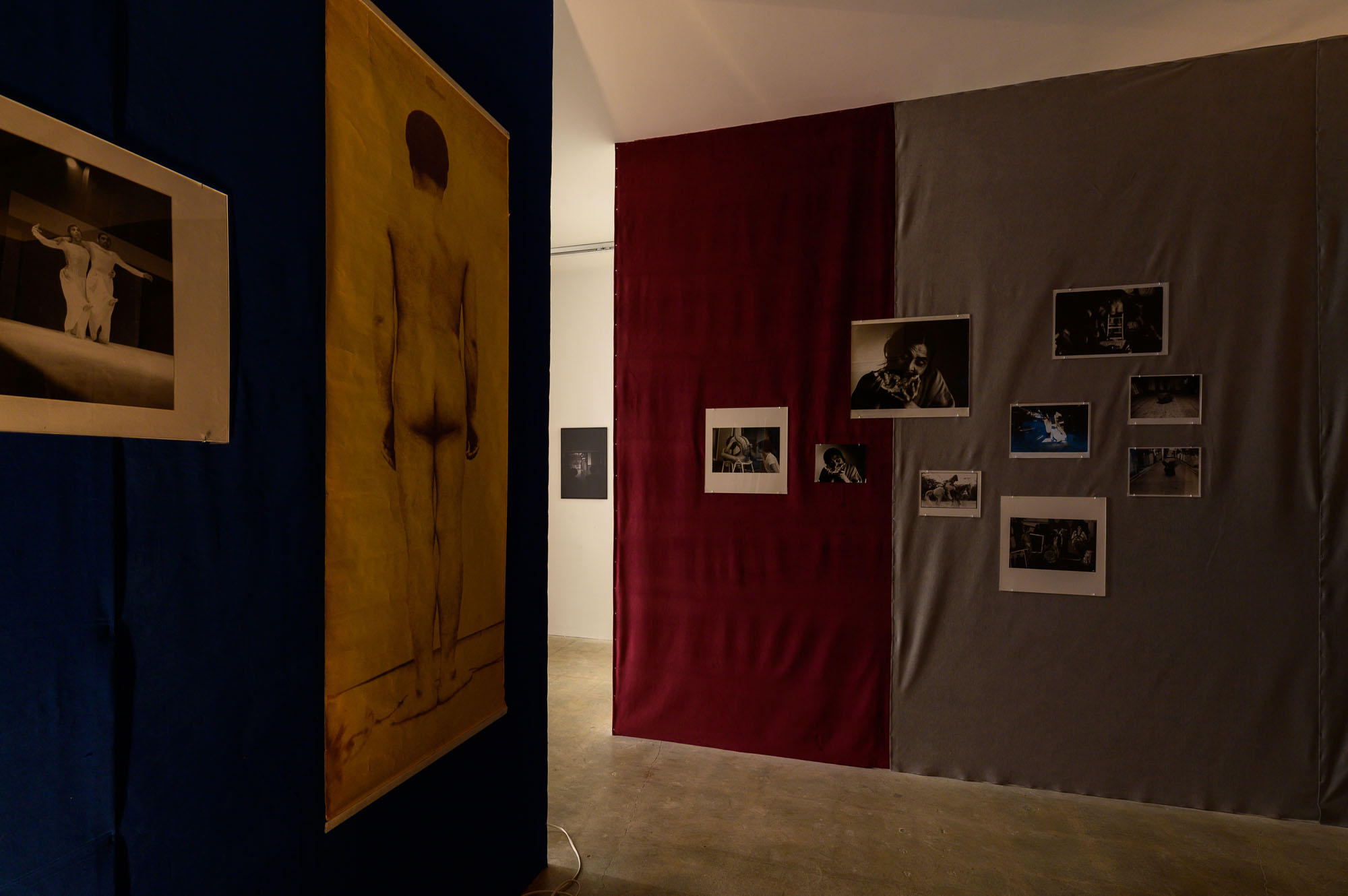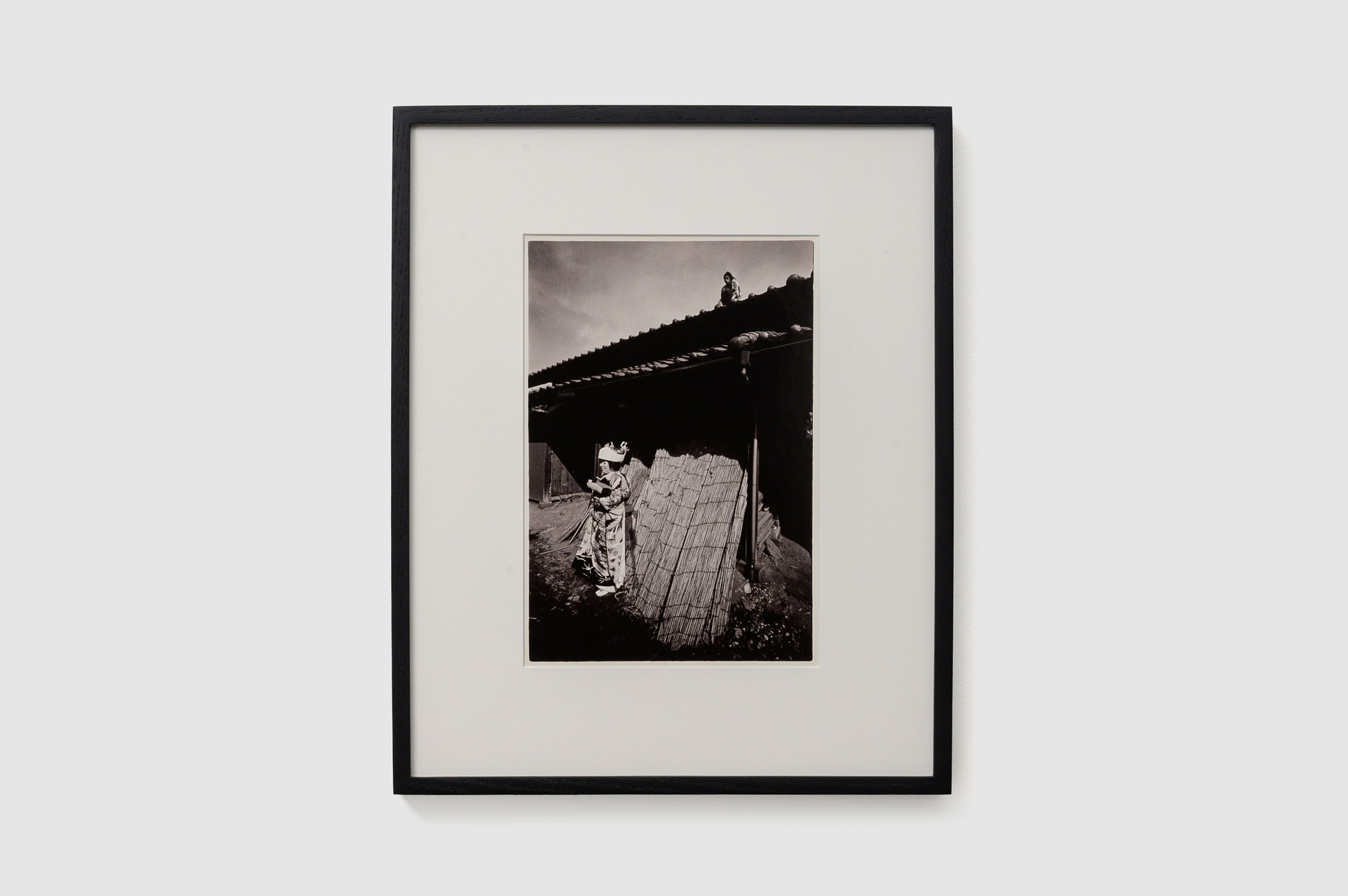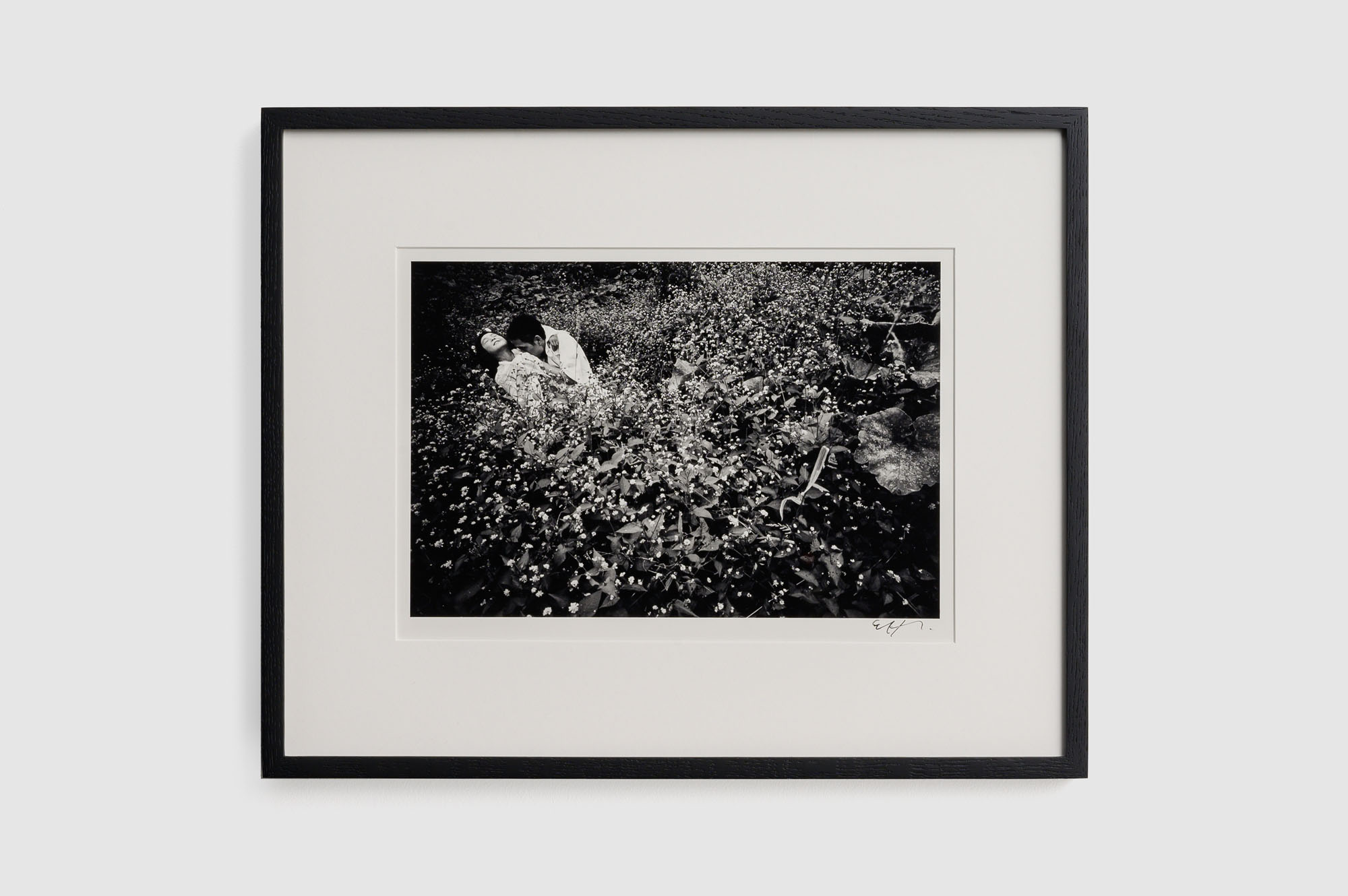Artists: Tatsumi Hijikata, Eikoh Hosoe
Exhibition title: Tatsumi Hijikata and Eikoh Hosoe: Collaborations with Tatsumi Hijikata
Venue: Nonaka-Hill, Los Angeles, US
Date: October 12 – November 30, 2019
Photography: Tatsumi Hijikata images © The Artists. Courtesy of Butoh Laboratory, Japan and Nonaka-Hill, Los Angeles. Eikoh Hosoe images © Eikoh Hosoe / Courtesy of Taka Ishii Gallery Photography / Film, Tokyo and Nonaka-Hill, Los Angeles
Tatsumi Hijikata
Tatsumi Hijikata was the founder of Ankoku Butoh (literally meaning, dance of darkness), widely known and practiced today, some 60 years later, as Butoh.
Hijikata arrived to Tokyo from the Northern rural Tohoku region in 1952 and worked blue-collar
jobs to support his dance pursuits. As his rural accent set him apart from Tokyo’s urbanites, Hijikata filled his time reading French writers, such as Jean Genet, Antonin Artaud and Georges Bataille. Aesthetically, he looked towards artists such as Egon Schiele, Hans Bellmer and Willem De Kooning. Hijikata’s provocative performances stemmed from this exploration of eros, debauchery, disease and death, evoking the rarely seen dark half of the human psyche. With awareness of German Expressionist dance and technical capabilities in Modern dance genres including jazz, flamenco, classical ballet and pantomime, Hijikata felt the imperative to develop a new dance form, and with the underlying notion of the anti-establishment, Hijikata’s Butoh stands as a form of anti-dance. The exhibition’s organizer, Takashi Morishita has written “Hijikata’s Butoh… is body art whose expression is a “convulsion of existence”‘.
As an artist working in performance with relationship to Happenings, a popular in his times, Tatsumi Hijikata became a central figure in Japan’s avant-garde and achieved lasting global influence. At Nonaka-Hill, Hijikata’s archival material including video, photography, posters and ephemera will be featured, resulting from collaborations with and documentation by Genpei Akasegawa, Nori Doi, Hideo Fujimori, Masahisa Fukase, Roku Hasegawa, Eikoh Hosoe, Masuo Ikeda, Kenji Ishiguro, Yukio Mishima, Hiroshi Nakamura, Natsuyuki Nakanishi, Tadao Nakatani, Makoto Onozuka, Kiyoshi Otsuji, Keiya Ouchida, Yutaka Takanashi, Ikko Tanaka / Hiroshi Yamasaki, Ryozen Tori, Tadanori Yokoo, Ruiko Yoshida and unknown others.
Tatsumi Hijikata is the first exhibition in the United States dedicated to Tatsumi Hijikata (1928-1986). Organized by Takashi Morishita and Butoh Laboratory, Japan, with cooperation of Keio University Art Canter, Tokyo. Special thanks to Yoshiko Shimada. The exhibition and brochure is made possible by a grant from The Pola Foundation.
Eikoh Hosoe: Collaborations with Tatsumi Hijikata
The celebrated photographer, Eikoh Hosoe (1933) was a long-time friend and collaborator of Tatsumi Hijikata, having first met in 1959 at Hijikata’s debut Ankoku Butoh performance, Forbidden Colors (Kinjiki), based on the novel by Yukio Mishima, with whom Hosoe would also create significant collaborations. Hosoe was then a member of the independent photo agency, VIVO along with Kikuji Kawada, Ikko Narahara, Akira Sato, Akira Tanno, Shomei Tomatsu. The VIVO photographers steered away from then popular objective realism towards a more subjective and expressive approach. In 1960, Hosoe founded the Jazz Film Laboratory (Jazzu Eiga Jikken-shitsu) to produce multi-disciplinary artworks. Featuring Tatsumi Hijikata in his early career, Hosoe’s intense black and white short film Navel and A-Bomb (Heso to genbaku), 1960 contemplates a new beginning provoked by the bombings of Hiroshima and Nagasaki.
As Japan urbanized in the economic boom period in the decades following WWII, Hosoe felt a growing sense of urgency to revisit the rural Tohoku region where he had been evacuated as a child to escape Tokyo air-raids. The photographer enlisted dancer Tatsumi Hijikata, who is from the same Tohoku region, to enact the “sickle-toothed weasel”, a vicious god of local folklore and a threat that terrorized the young displaced Hosoe, who also associates his time in that region with an innocent happiness within an otherwise dark period. Hosoe said:
In the village, he played with children, was laughed at by farmers along the roadside, shat in the middle of a field, attacked a bride, kidnapped a baby, and ran through the rural landscape. Almost all the shooting was done guerrilla style in a flash. This was something that could only be achieved through photography. No other medium — film, television, painting, or novel — could have been used in its place. At that moment, I was certain of the superiority of photography.
Eikoh Hosoe, “Foreword” in Kamaitachi 1
Indeed, Hosoe’s high-contrast and theatrical photographs perfectly emphasized the corporeality of Hijikata’s impromptu performances and the rough-hewn textures of the mostly rural locales. While exploring a shared affinity for a specific place, the artists co-created a suite of images, light-hearted and brooding, and abundant of metaphor. The Kamaitachi photographs (1965-1968) were published as a book by the same name in 1969, which has since been re-issued numerous times.
Eikoh Hosoe (1933 – ) is one of the best-known photographers of Japan’s post-war era. His work has been the subject of numerous solo and group exhibitions in Japan and abroad, and is held in innumerable public collections. Hosoe is the recipient of several awards, including The Medal with Purple Ribbon (1998), The Royal Photographic Society (England) Special 150th Anniversary Medal Award (2003), The Order of the Rising Sun (2007), the Mainichi Art Award (2008), and was designated as a Person of Cultural Merit by the Ministry of Education in 2010. Since its opening in 1995, Hosoe has served as Director of The Kiyosato Museum of Photographic Arts, Hokuto, Yamanashi Prefecture, Japan .
[1] Eikoh Hosoe, “Kamaitachi,” Shashin Hosoe Eikoh no sekai (Eikoh Hosoe Photographs 1951 – 1988), Shashin Hosoe Eikoh no sekaiten jikko iinkai, 1988
Tatsumi Hijikata, 2019, exhibiton view, Nonaka-Hill, Los Angeles
Tatsumi Hijikata, 2019, exhibiton view, Nonaka-Hill, Los Angeles
Tatsumi Hijikata, 2019, exhibiton view, Nonaka-Hill, Los Angeles
Tatsumi Hijikata, 2019, exhibiton view, Nonaka-Hill, Los Angeles
Tatsumi Hijikata, 2019, exhibiton view, Nonaka-Hill, Los Angeles
Tatsumi Hijikata, 2019, exhibiton view, Nonaka-Hill, Los Angeles
Tatsumi Hijikata, 2019, exhibiton view, Nonaka-Hill, Los Angeles
Tatsumi Hijikata, 2019, exhibiton view, Nonaka-Hill, Los Angeles
Tatsumi Hijikata, 2019, exhibiton view, Nonaka-Hill, Los Angeles
Tatsumi Hijikata, 2019, exhibiton view, Nonaka-Hill, Los Angeles
Tatsumi Hijikata, 2019, exhibiton view, Nonaka-Hill, Los Angeles
Tatsumi Hijikata, 2019, exhibiton view, Nonaka-Hill, Los Angeles
Tatsumi Hijikata, 2019, exhibiton view, Nonaka-Hill, Los Angeles
Tatsumi Hijikata, 2019, exhibiton view, Nonaka-Hill, Los Angeles
Tatsumi Hijikata, 2019, exhibiton view, Nonaka-Hill, Los Angeles
Tatsumi Hijikata, 2019, exhibiton view, Nonaka-Hill, Los Angeles
Tatsumi Hijikata, 2019, exhibiton view, Nonaka-Hill, Los Angeles
Tatsumi Hijikata, 2019, exhibiton view, Nonaka-Hill, Los Angeles
Tatsumi Hijikata, 2019, exhibiton view, Nonaka-Hill, Los Angeles
Tatsumi Hijikata, 横尾忠則(細江英公) : 土方巽と日本人, Design by Tadanori Yokoo, Revolt of the Body Poster, 1968, Silkscreen, 40 1/2 x 28 1/2 in
Tatsumi Hijikata, 細江英公: 鎌鼬・記念写真, Photograph by Eikoh Hosoe, Commemorative Photograph for Eikoh Hosoe Winning The Ministry of Education, Science andCulture’s Arts Encouragement Prize for Kamaitachi, 1969, 9 5/8 x 11 3/4 in
Tatsumi Hijikata, 赤瀬川原平: 易断面相図幕, Work by Genpei Akasegawa, I Ching Accupuncture Chart for Rose-Colored Dance, 1965, Chinese ink on cloth, 190 x 255 cm
Tatsumi Hijikata, 赤瀬川原平: 易断面相図幕, Work by Genpei Akasegawa, I Ching Accupuncture Chart for Rose-Colored Dance, 1965, Chinese ink on cloth, 190 x 255 cm
Tatsumi Hijikata, 赤瀬川原平: 易断面相図幕, Work by Genpei Akasegawa, I Ching Accupuncture Chart for Rose-Colored Dance, 1965, Chinese ink on cloth, 190 x 255 cm
Tatsumi Hijikata, 赤瀬川原平: 易断面相図幕, Work by Genpei Akasegawa, I Ching Accupuncture Chart for Rose-Colored Dance, 1965, Chinese ink on cloth, 190 x 255 cm
Tatsumi Hijikata, 赤瀬川原平: 易断面相図幕, Work by Genpei Akasegawa, I Ching Accupuncture Chart for Rose-Colored Dance, 1965, Chinese ink on cloth, 190 x 255 cm
Tatsumi Hijikata, 赤瀬川原平: 易断面相図幕, Work by Genpei Akasegawa, I Ching Accupuncture Chart for Rose-Colored Dance, 1965, Chinese ink on cloth, 190 x 255 cm
Tatsumi Hijikata, 大辻清司: 禁色, Photograph by Kiyoji Ōtsuji, Forbidden Colors Rehearsal at Asbestos Hall, 1959, 18.2 x 27.3 cm
Tatsumi Hijikata, 大辻清司: 禁色(改訂版), Photograph by Kiyoji Ōtsuji, Forbidden Colors 2nd Performance, 1959, 19.5 × 27.3 cm
Tatsumi Hijikata, 横尾忠則: バラ色ダンス, Design by Yokoo Tadanori Rose-Colored Dance Poster , 1965, 40 5/16 x 28 3/4 in
Tatsumi Hijikata, 田中一光(山崎博): 静かな家, Design by Ikko Tanaka, Photograph by Hiroshi Yamazaki, Quiet House (Part I), 1973, 42 7/8 x 31 in
Tatsumi Hijikata, 吉田ルイ子: 「静かな家」舞台写真, Photograph by Ruiko Yoshida, Quiet House, 1973, 8 1/16 x 10 in
Tatsumi Hijikata, 吉田ルイ子: 「静かな家」舞台写真, Photograph by Ruiko Yoshida, Quiet House, 1973, 8 1/16 x 10 in
Tatsumi Hijikata, 吉田ルイ子: 「静かな家」舞台写真, Photograph by Ruiko Yoshida, Quiet House, 1973, 8 1/16 x 10 in
Tatsumi Hijikata, 小野塚誠: 「静かな家」舞台写真, Photograph by Takeshi Onozuka, Quiet House, 1973, 8 1/16 x 10 in
Tatsumi Hijikata, スクラップブック(写真版), Scrapbook (Facsimile), 1972-76, Print and panel, 43.5 × 64.5 cm
Tatsumi Hijikata, スクラップブック(写真版), Scrapbook (Facsimile), 1972-76, Print and panel, 43.5 × 64.5 cm
Tatsumi Hijikata, スクラップブック(写真版), Scrapbook (Facsimile), 1972-76, Print and panel, 43.5 × 64.5 cm
Tatsumi Hijikata, スクラップブック(写真版), Scrapbook (Facsimile), 1972-76, Print and panel, 43.5 × 64.5 cm
Tatsumi Hijikata, スクラップブック(写真版), Scrapbook (Facsimile), 1972-76, Print and panel, 43.5 × 64.5 cm
Tatsumi Hijikata, Photograph by unknown: レダ, Leda, 1962, 29.8 x 42 cm, 29.8 x 42 cm
Tatsumi Hijikata, 深瀬昌久: スイカを喰う土方巽(大), Photograph by Masahisa Fukase, Tatsumi Hijikata Eating a Watermelon (large), 1970, 17 7/8 x 19 7/8 in
Tatsumi Hijikata, 石黒健治: 風呂敷男 (アスベスト館内), Photograph by Kenji, Ishiguro, Furoshiki Otoko (Inside Asbestos Hall), 1970, 20.3 × 25.4 cm
Tatsumi Hijikata, 石黒健治: 風呂敷男 (外), Photograph by Kenji Ishiguro, Furoshiki Otoko (outdoor), 1970, 8 1/16 x 10 in
Tatsumi Hijikata, 高梨豊: 鶏小屋の土方巽, Photograph by Yutaka Takanashi, Tatsumi Hijikata inside a Chicken Coop, 1969, 23.7 × 30.4 cm
Tatsumi Hijikata, 中谷忠雄: アスベスト館ハプニング, Photograph by Tadao Nakatani, Asbestos Hall Happening, 1968, 49.8 × 41.3 cm
Tatsumi Hijikata, 深瀬昌久: 白馬に乗る土方巽, Photograph by Masahisa Fukase, Tatsumi on a White Horse, 1970, 8 1/8 x 10 in
Tatsumi Hijikata, 深瀬昌久: スイカを喰う土方巽(小), Photograph by Masahisa Fukase, Tatsumi Hijikata Eating a Watermelon (small), 1970, 7 x 9 in
Tatsumi Hijikata, 中谷忠雄: 形而情學 (解剖図を描く), Photograph by Tadao Nakatani, Emotion in Metaphyics (Natsuyuki Nakanishi Painting Anatomy), 1967, 50 × 41.3 cm
Tatsumi Hijikata, 中西夏之: 男子背面,Work by Natsuyuki Nakanishi, Back of Natsuyuki Nakanishi (From General Catalogue of Males ’63) , 1961, Blue print, 168.5 x 66.7 cm
Tatsumi Hijikata, 細江英公: バラ色ダンス (土方と大野一雄), Photograph by Eikoh Hosoe, Rose-Colored Dance (Tatsumi Hijikata and Kazuo Ohno), 1965, 50 × 41.2
Tatsumi Hijikata, Photograph by unknown: バラ色ダンス(玉野背中), Rose-Colored Dance (Tamano’s Back), 1965, 48.3 x 32.8 cm
Tatsumi Hijikata, 細江英公: バラ色ダンス(フェンシング), Photograph by Eikoh Hosoe, Tatsumi Hijikata Performing Fencing Sequence in Rose-Colored Dance, 1965, 38.8 x 53.5 cm
Tatsumi Hijikata, Photograph by unknown: バラ色ダンス(床屋), Rose-Colored Dance (Barber Shop), 1965, 32.8 x 48.3 cm
Tatsumi Hijikata, Photograph by unknown: 晩年の土方巽, Tatsumi Hijikata in late years, 1985, 1985, 59.4 x 42 cm
Tatsumi Hijikata, Photograph by unknown: 肉体の叛乱 (行進), Revolt of the Body (Marching), 1968, 32.8 x 48.3 cm
Tatsumi Hijikata, 長谷川六: 肉体の叛乱 (赤ドレス), Photograph by Roku Hasegawa, Revolt of the Body (Red Dress), 1968, 51.5 x 63.1 cm
Tatsumi Hijikata, 中谷忠雄: 肉体の叛乱 (フィナーレ), Photograph by Tadao, Nakatani, Revolt of the Body (Finale), 1968, 50 × 41.3 cm
Tatsumi Hijikata, 鳥居良禅: 肉体の叛乱 (男根), Photograph by Ryozen Torii, Revolt of the Body, Tatsumi Hijikata Wearing a Golden Phallus, 1968, 77.2 × 51.6 cm
Tatsumi Hijikata, 土井典: 模造男根, Work by Nori Doi, Phallic appendage worn by Tatsumi Hijikata in Hijikata Revolt of the Body, 1968
Tatsumi Hijikata and Eikoh Hosoe: Collaborations with Tatsumi Hijikata, 2019, exhibiton view, Nonaka-Hill, Los Angeles
Tatsumi Hijikata and Eikoh Hosoe: Collaborations with Tatsumi Hijikata, 2019, exhibiton view, Nonaka-Hill, Los Angeles
Tatsumi Hijikata and Eikoh Hosoe: Collaborations with Tatsumi Hijikata, 2019, exhibiton view, Nonaka-Hill, Los Angeles
Eikoh Hosoe: Collaborations with Tatsumi Hijikata, 2019, exhibiton view, Nonaka-Hill, Los Angeles
Eikoh Hosoe: Collaborations with Tatsumi Hijikata, 2019, exhibiton view, Nonaka-Hill, Los Angeles
Eikoh Hosoe: Collaborations with Tatsumi Hijikata, 2019, exhibiton view, Nonaka-Hill, Los Angeles
Eikoh Hosoe: Collaborations with Tatsumi Hijikata, 2019, exhibiton view, Nonaka-Hill, Los Angeles
Eikoh Hosoe: Collaborations with Tatsumi Hijikata, 2019, exhibiton view, Nonaka-Hill, Los Angeles
Eikoh Hosoe: Collaborations with Tatsumi Hijikata, 2019, exhibiton view, Nonaka-Hill, Los Angeles
Eikoh Hosoe: Collaborations with Tatsumi Hijikata, 2019, exhibiton view, Nonaka-Hill, Los Angeles
Eikoh Hosoe: Collaborations with Tatsumi Hijikata, 2019, exhibiton view, Nonaka-Hill, Los Angeles
Eikoh Hosoe, Kamaitachi #13, 1965/2014, Gelatin silver print
Eikoh Hosoe, Kamaitachi #37, 1965/2014, Gelatin silver print
Eikoh Hosoe, Kamaitachi #14, 1965/ ca. 1970, Gelatin silver print
Tatsumi Hijikata, 細江英公: 鎌鼬(ハサ), Photograph by Eikoh Hosoe, Kamaitachi, 1965, 9 x 6 1/4 in (outside), 10 x 8 in (outside)
Eikoh Hosoe, Kamaitachi #5, 1965/1989, Gelatin silver print
Eikoh Hosoe, Kamaitachi #17, 1965/2007, Gelatin silver print
Eikoh Hosoe, Kamaitachi #18, 1965/ ca. 1970, Gelatin silver print
Eikoh Hosoe, Kamaitachi #19, 1965/ 2007, Gelatin silver print.
Eikoh Hosoe, Kamaitachi #41, 1968/2013, Gelatin silver print
Eikoh Hosoe, Kamaitachi #29, 1968/ ca. 1970, Gelatin silver print
Eikoh Hosoe, Kamaitachi #28, 1968/ ca. 1970, Gelatin silver print
Eikoh Hosoe, Kamaitachi #20, 1965/ ca. 1970, Gelatin silver print
Eikoh Hosoe, Kamaitachi #23, 1965/2014, Gelatin silver print
Eikoh Hosoe, Kamaitachi #36, 1968/2007, Gelatin silver print
Eikoh Hosoe, Kamaitachi #32, 1965/ ca. 1970, Gelatin silver print
Eikoh Hosoe, Kamaitachi #11, 1965/ ca. 1970, Gelatin silver print
Eikoh Hosoe, Kamaitachi #9, 1965/ ca. 1970, Gelatin silver print
Eikoh Hosoe, Kamaitachi #25, 1965/ ca. 1970, Gelatin silver print
Eikoh Hosoe, Kamaitachi #34, 1965/1989, Gelatin silver print
Eikoh Hosoe, Kamaitachi #3, 1965/ ca. 1970, Gelatin silver print
Eikoh Hosoe, Kamaitachi #31, 1968/2015, Gelatin silver print


































































































